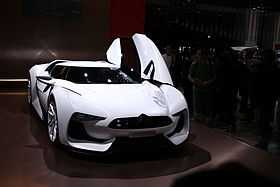GT by Citroën
| GT by Citroën | |
|---|---|
 |
|
| Overview | |
| Manufacturer | Citroën |
| Designer | Takumi Yamamoto |
| Body and chassis | |
| Class | Sports car prototype |
| Body style | Two seater, mid-engined coupé |
| Layout | Four-wheel drive |
| Powertrain | |
| Engine | 778 bhp (580 kW) x4 hydrogen fuel cell (in the game), 646 hp (482 kW) 5.4L Ford V8 (in real life) |
| Transmission | 7-speed "circle" sequential gearbox |
| Dimensions | |
| Wheelbase | 2,810 mm (110.6 in) |
| Length | 4,960 mm (195.3 in) |
| Width | 2,080 mm (81.9 in) |
| Height | 1,090 mm (42.9 in) |
| Curb weight | 1,400 kg (3,086 lb) |
The GT by Citroën (sometimes spelled GTbyCitroën) is a sports car that debuted as a concept car on October 2 at the 2008 Paris Motor Show. The car is a collaboration between the French automaker Citroën and the Japanese racing simulation developer Polyphony Digital. Six cars are expected to be built. The expected MSRP is $2,100,000.
The GT by Citroën concept car was specially created, designed and produced for the video game Gran Turismo 5 and was included through download in its initial version Gran Turismo 5 Prologue. Its designer came up with the project and sold it to both Polyphony Digital and Citroën.
The car's exterior design was made by Takumi Yamamoto, a Japanese designer from Jean-Pierre Ploué's Style Citroën design team. Takumi Yamamoto was a childhood friend of Kazunori Yamauchi, director of Polyphony Digital and creator of the popular Gran Turismo franchise, also known as "Gegge". According to a Yamauchi interview at the Paris Motor Show 2008, he and Yamamoto started collaborating on this project back in 2003. A press release published on the North American Gran Turismo official website describes the Citroën and Polyphony Digital collaboration as a « a joint effort first talked about at the Geneva Motor Show past March [2008] ». Yamamoto convinced Jean-Pierre Ploué to submit his concept to Citroën's head office in Paris who agreed to start the production process and manufacture the real car. The concept car's rear was carefully designed to fit what the gamers will actually see in the game since it is the more powerful featured vehicle, argues Yamamoto.
As a world leading racing simulation developer shipping more than 50 million copies since 1998 Polyphony Digital had collaborated with real life Japanese performance parts makers and tuners, mainly related to Nissan, since January 2002. Notable collaborations include aero parts development for the Nismo Fairlady Z s-tune (2002), Nismo Skyline Coupé (2004), Amuse S2000 Street Version (2003), Nismo Fairlady Z (2005), Opera Performance's Carmate Opera Z (2005) Tokyo Auto Salon show car. Polyphony Digital also did exterior design for the Amuse S2000 GT1 (2005) and artwork design for the Formula Nippon racing team Impul racer (2006).
...
Wikipedia
